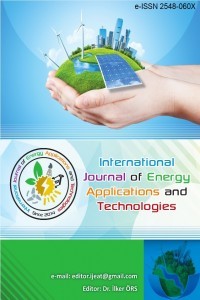Thermodynamic analysis of an ejector cooling system using R123 as refrigerant under different working conditions
Thermodynamic analysis of an ejector cooling system using R123 as refrigerant under different working conditions
Ejector, COP, Entrainment ratio Temperature, Simulation, Cooling,
___
- [1] Carrillo, J. E., de La Flor, F. S., & Lissén, J. S., 2017, “Thermodynamic comparison of ejector cooling cycles. Ejector characterisation by means of entrainment ratio and compression efficiency”, International Journal of Refrigeration, 74, 371-384.
- [2] Yapıcı, R., & Ersoy, H. K., 2005, “Performance characteristics of the ejector refrigeration system based on the constant area ejector flow model”, Energy conversion and management, 46(18-19), 3117-3135.
- [3] Chen, X., Omer, S., Worall, M., & Riffat, S., 2013, “Recent developments in ejector refrigeration technologies”, Renewable and Sustainable Energy Reviews, 19, 629-651.
- [4] Yilmaz, F., Selbaş, R., & Üçgül, İ., 2014, “Ejektörlü Soğutma Sisteminin Teorik Olarak İncelenmesi”, SDÜ Yekarum e-Dergi, 2(2).
- [5] Yang, X., & Zhao, L., 2015, “Thermodynamic analysis of a combined power and ejector refrigeration cycle using zeotropic mixtures”, Energy Procedia, 75, 1033-1036.
- [6] Besagni, G., Mereu, R., & Inzoli, F., 2016, “Ejector refrigeration: a comprehensive review”, Renewable and Sustainable Energy Reviews, 53, 373-407.
- [7] Özen, D.N., Tolu, M.E., 2016, “Theoretical analysis of a cooling system with an ejector for different refrigerants,” in IEESE8, p. 1198-1202.
- [8] Ma, Z., Bao, H., & Roskilly, A. P., 2017, “Thermodynamic modelling and parameter determination of ejector for ejection refrigeration systems”, International Journal of Refrigeration, 75, 117-128.
- [9] Yapıcı, R., Ersoy, H. K., Aktoprakoğlu, A., Halkacı, H. S., & Yiğit, O., 2008, “Experimental determination of the optimum performance of ejector refrigeration system depending on ejector area ratio”, International Journal of Refrigeration, 31(7), 1183-1189.
- [10] Chen, J., Jarall, S., Havtun, H., & Palm, B., 2015, “A review on versatile ejector applications in refrigeration systems”, Renewable and Sustainable Energy Reviews, 49, 67-90.
- Yayın Aralığı: Yılda 2 Sayı
- Başlangıç: 2014
- Yayıncı: İlker ÖRS
Investigation of the energy (biogas) production from co-digestion of organic waste materials
Aniekan IKPE, Patric EBUNİLO, John OKOVİDO
Design and analysis of PV fed SRM system
Serhat Berat EFE, Dilan DEMİR AKTAŞ
Greenough River Solar Farm case study & validation initialization
Burak Omer SARACOGLU, Angus KİNG
